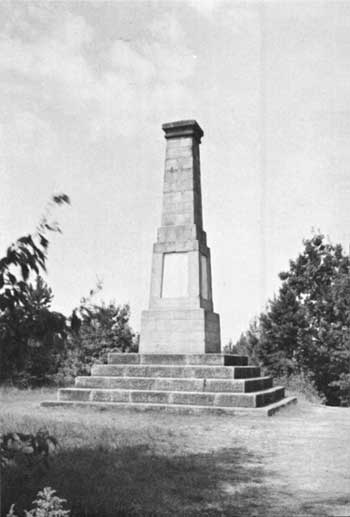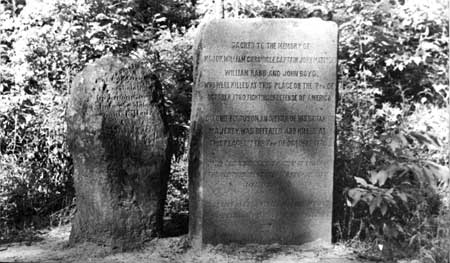|
KINGS MOUNTAIN National Military Park |
 |
Your Guide to the Area
The battlefield ridge is the most outstanding feature of the park. Beginning at the Administration and Museum Building, numbered markers have been placed at the principal points of interest along the trail. These markers correspond with the numbered paragraphs below and with the numbers on the guide map. For the best story on the ground, it is suggested that you fellow them in the order given.
I. THE ADMINISTRATION AND MUSEUM BUILDING. Before you set out on the self-guiding, walking tour of the battlefield ridge, you will enjoy a visit to the park museum in this building. Colorful displays and exhibits explain simply and clearly the causes and results of the Battle of Kings Mountain and the turn of events that followed it in the Southern Campaign of the American Revolution. A series of exhibits trace the origin of the mountain men, tell the story of their uprising, and show their route of march to Kings Mountain. Other displays explain the progress of the British invasion of the South and the movement of Ferguson's corps before the battle.
Among the featured exhibits are the battlefield diorama, typical arms of the mountain men, an electric map showing routes of the forces engaged in the battle, and examples of the Kentucky and Ferguson rifles. The diorama is a three-dimensional reenactment in miniature of a typical Kings Mountain battle scene. The original Ferguson rifle came from Scotland and is one of the park's prized possessions.
2. THE FIRST SHOT. Close to this location Tory soldiers fired upon the advancing frontiersmen. This was the first warning to Ferguson that he was about to be engaged in battle. Shortly before, other patriot units passed here toward assigned positions on the southwest and southeast slopes of the ridge. They followed an Indian trail closely paralleled by the route of the main park drive.
3. THE BATTLE BEGINS. The first shot of the battle was the signal for all the patriot units that were in position around the base of the ridge to commence their attack. Here Sevier and Campbell merged their forces as they engaged Ferguson's Provincial troops in bitter hand-to-hand fighting. They gained ground, only to lose it again, as they were repulsed by repeated bayonet charges. But by their heroic action near this spot, patriot troops on the northeast end of the ridge were enabled to complete the encirclement of Ferguson's position.

The Centennial Monument, erected in 1880
through public and private subscription.
4. HIGHEST PEAK OF THE BATTLE RIDGE. This spot marks the south western end of Ferguson's battle position, which extended the entire length of the ridge. The Centennial Monument erected in 1880 to commemorate the American patriots who defeated Ferguson is also located at this point. It is placed upon ground that was overrun by the men of Shelby, Sevier, and Campbell who, by their gallantry, forced Ferguson's troops to retire toward the British campsite.
5. PATRIOT ADVANCE CONTINUES. Bitterly fighting all the while, Tory forces were gradually pushed back along the top of the ridge in this area. Here Ferguson had hoped to establish a position from which he could better withstand the relentless attack of the mountain men.
6. SITE OF THE SURRENDER. After constant attack from all sides for nearly an hour, Ferguson's troops were forced into the clearing at this point which has changed little since 1780. At this time Ferguson was killed and the command passed to Capt. Abraham de Peyster, who very shortly realized that further resistance was useless and in this area surrendered the remaining Tory troops.
The impressive monument or obelisk at this location was erected in 1909 by the United States Government to memorialize the significant American victory at Kings Mountain.
7. TRADITIONAL SPOT WHERE FERGUSON WAS WOUNDED. Near this spot and in the late stages of the engagement, Ferguson, riddled with at least eight balls, fell from his white charger. One battle account states that one of these balls was fired by Robert Young, who is reported to have said in referring to his rifle, as he took aim and fired at Ferguson: "I'll try and see what Sweet-Lips can do." The small marker stands where the British commander is believed to have been mortally wounded.
8. FERGUSON'S GRAVE. This was first marked by the granite block to the northeast of the pile of stones. The tablet on the opposite side was dedicated October 7, 1930, by President Hoover on the occasion of the Sesquicentennial Celebration. The rock pile originates from the Scottish tradition of placing a cairn over the grave of a fallen chieftain.

The Chronicle Markers. On the left is the original stone, erected
1815, which was replaced with the newer marker in 1914. These stones
mark the graves of Maj. William Chronicle Capt. John Mattocks, William
Rabb, and John Boyd; patriots killed in the battle.
9. THE CHRONICLE MARKERS. On July 4, 1815, Dr. William McLean visited the battlefield and dedicated the gray soft stone on your left. It stands at the grave of his friend, Maj. William Chronicle, who is buried here with Capt. John Mattocks, William Rabb, and John Boyd. It is one of the oldest battlefield markers in the country. One hundred years later, in 1914, the Kings Mountain Association of Yorkville (now York), S. C., erected the newer marker to preserve the time-and-weather-worn inscription on the original.
10. SPRING. One of the principal advantages of Ferguson's campsite was its water supply which continues to originate from several sources. This is one of two springs to which the wounded of both sides are believed to have made their way for water. About 200 yards ahead, where the trail makes a hairpin turn to the right, you will pass a second spring on your left which was probably also used during the battle.
11. POSITIONS OF SHELBY AND SEVIER. As you move up the trail to the upper parking area, you pass through the lines of Shelby and Sevier, coorganizers of the patriot march to Kings Mountain. Along the way are points where they began their attacks which were timed with the movements of Campbell's men on the opposite slope of the ridge.

|
|
Last Modified: Mon, Dec 2 2002 10:00:00 am PDT |


